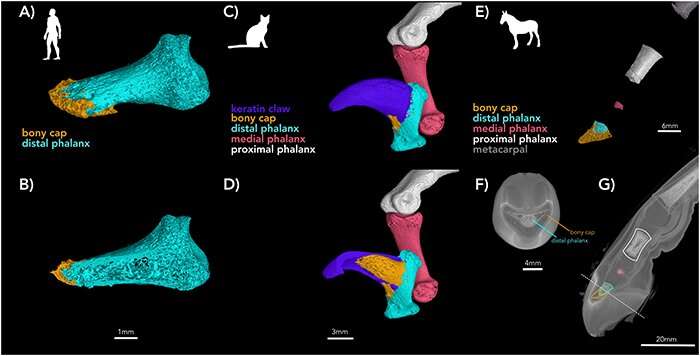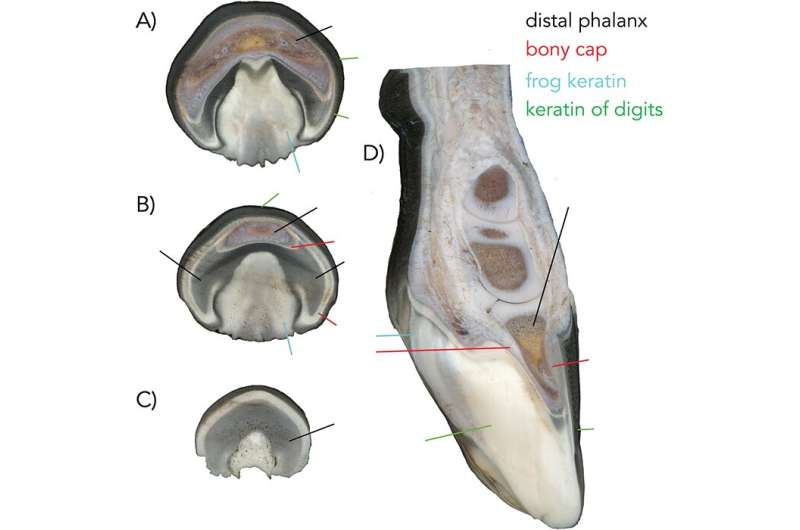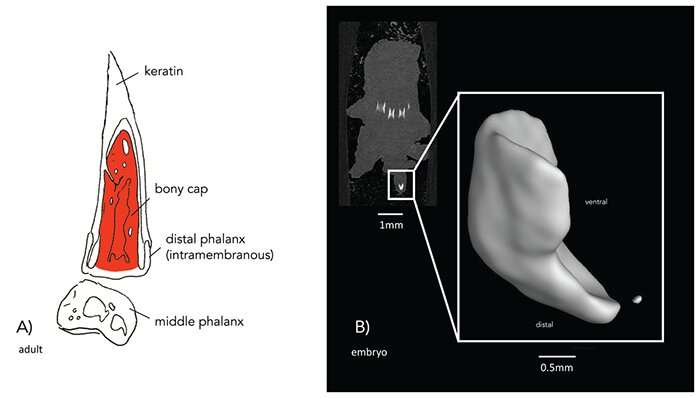A, C, E (top) are the external views of an adult human, cat, and a juvenile horse, respectively. The bony cap is depicted in yellow, the distal phalanx is blue, and the middle phalanx is red. B, D, F, G (bottom) are cross-sections of the same specimens. Credit: PeerJ (2023). DOI: 10.7717/peerj.14352
In the late 19th century, researchers discovered, in separate studies, that horses and humans have a small bone at the tip of their hoof and finger, respectively. Since then, research on the anatomical development of many animals—including horses, humans, and other species—has forged on, but little attention has since been given to this bony structure, which went unnamed for more than 100 years.
Now, College of Osteopathic Medicine (NYITCOM) researchers, including Professor of Anatomy Nikos Solounias, Ph.D., and medical student Shannon Smith, are resurfacing this small but mighty structure and ensuring that it does not become lost within scientific literature. In a study published on January 10 in PeerJ, they make the case for why this structure—which they dub "the bony cap"—may play a large role in digit (finger and toe) regeneration and nail growth.
The researchers analyzed the anatomy of fetal and adult humans, horses, and cats via microscopic tissue samples and scans obtained through micro-computed tomography (micro-CT), an imaging technique that captures microscopic images of specimens' internal spaces and recreates virtual 3D models without dissection.
They discovered that the bony cap was present on all digits in all three species. During development, the bony cap is a distinct anatomical structure that later fuses with the area at the tip of the digit called the distal phalanx.
The project began when Solounias first noticed the presence of the bony cap in developing humans, which he notes was a good place to start, as human anatomy can be much simpler than other species. An analysis of adult bones from the NYITCOM Anatomy Lab showed the presence of a bony cap that had fused with the distal phalanx.
The real anatomical sections of the “finger” of a fetal horse. The bony cap is noted by a red pointer, distinct from the distal phalanx noted by a black pointer. Credit: PeerJ (2023). DOI: 10.7717/peerj.14352
The study was extended to horses, which have very complex anatomy because their hooves contain five separate digits fused into one, as Solounias noted in a pioneering 2018 study. Much like humans, horses had a very distinct bony cap during development that seemed to later fuse with the distal phalanx by adulthood.
Cats, however, proved to be a particularly interesting case. Unlike the bony caps of horses and humans, those in cats were hollow and adjacent to the distal phalanx. The authors believe that these distinct features may play a role in allowing cats to retract their claws.
Regardless of these differences, the researchers conclude that "the bony cap may play a significant role in nail formation in humans, claw formation in cats, and hoof formation in horses." They also call for future studies that examine how the bony cap may impact nail formation in other animals, stating, "Its ubiquity across mammals, and even tetrapods (four-footed animals), needs further consideration."
In addition, the findings may improve the scientific understanding of digit regeneration. For example, young babies re-heal and grow back the distal phalanx, but this regeneration likely requires the bony cap to act as a catalyst. To further demonstrate this, the authors cite existing animal studies that found amputated digits closer to the limb were unable to regenerate bone.
A depiction of the bony cap in an adult cat is shown in red. Right: A 2-D and 3-D image, captured using the microCT scanner in the NYITCOM Department of Anatomy’s Visualization Center, shows the segmented bony cap of a fetal cat. Credit: PeerJ (2023). DOI: 10.7717/peerj.14352
"When considering this, it may be possible that the bony cap is responsible for bone regrowth in amniotes (mammals, birds, and reptiles)," the authors write.
The study is the result of a collaboration between NYITCOM faculty, students, and staff. Smith assisted Solounias with his research and co-authored the paper, while Research Technician Kelsi Hurdle captured high-resolution images of embryonic specimens via the microCT scanner housed in the Department of Anatomy's Visualization Center.
Smith and Solounias also collaborated externally with comparative and embryology expert Laurel Yohe, Ph.D., a researcher affiliated with the University of North Carolina at Charlotte and Yale University. Yohe facilitated the data collection and scanning of multiple adult specimens via facilities at Yale University and co-authored the study. She also helped in writing the manuscript.
More information: Shannon Smith et al, The bony cap and its distinction from the distal phalanx in humans, cats, and horses, PeerJ (2023). DOI: 10.7717/peerj.14352
Journal information: PeerJ
Provided by New York Institute of Technology


























